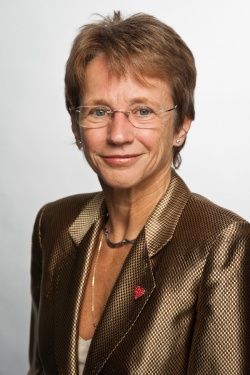Gender medicine
The insight that psychological, social and environmental conditions affect a person’s health is insufficiently considered in medical training and in the every-day diagnosis and treatment of patients.


Apart from gender-specific diseases, there is little medical research on ‘women’s health’ and ‘men’s health’.
Gender medicine as a research area was founded in the mid-1980s by the US-American cardiologist Marianne Legato who also coined the term. ‘Gender’ refers to the social construct, meaning the social and cultural roles of women and men and their tasks in every-day life, while ‘sex’ refers to the biological sex constituted by the biological differences between the genders. English is the only language that makes this distinction.
Gender medicine starts from the vantage point that diseases can manifest differently in men and women and thus diagnosis, therapy and medication have to be gender-specific. These differences might stem from biological (anatomy, hormones, chromosomes) as well as the psychosocial differences (lifestyles, culture, environment) in men and women.
‘Gender-specific research continues to confirm the impact of psychosocial and psychological variables of diseases. The variables influence the course of the disease as well as recovery and are thus important factors of the clinical outcomes and well-being of patients,’ says Professor Vera Regitz-Zagrosek MD, who directs the Institute for Gender Research in Medicine (GiM) at Charité, Berlin. The Institute also hosts the pilot project Gender Medicine, which monitors and classifies research on gender medicine issues and makes it publicly available.
National and discipline-specific differences
One way or another, many countries incorporate gender medicine. For example, in Sweden healthcare policy actively promotes gender equity. In Austria, gender medicine is a mandatory topic in medical training and also looks at patients and their gender-specific reaction to physicians and staff. According to one study, patients have the highest confidence in older male physicians and the least in younger female physicians.
Today, gender medicine is quite well established in cardio-vascular, pulmonary and autoimmune diseases as well as in rheumatology and endocrinology. Significant gender-differences are also known in neurological and gastroenterological diseases. The issue of medication, however, is severely under-researched. Many trials are still conducted exclusively with male subjects although it has been known for quite some time that many drugs act differently in men and women. Moreover, men and women communicate very differently. Men tend to be reluctant to express pain, whereas women, frequently more in tune with their body, describe pain in a more detailed way. Thus, in the USA and the United Kingdom gender-specific interview methods and communication training have been incorporated in the medical curricula.
Consequences for diagnosis and therapy
Gender medical research has shown that the classification of diseases as ‘typically male’ or ‘typically female’ can have a fatal effect: these stereotyped diseases are not recognised in the other gender, also because they tend to show different symptoms in men and women. Gender and age differences can be present in bone density, vessel thickness and metabolism. Moreover, there are differences in the size of internal organs, cardiac activity, body water/fat ratio and last but not least in physiognomy, size and weight. Women, for example, tend to have a smaller patella than men and due to the female pelvis anatomy have a higher risk of wear in the knees. Yet, it was 2007 before these differences began to be considered in knee implant construction.
Significant gender differences are confirmed in rheumatic and cardiovascular diseases. Today we know that myocardial infarction and stroke are by no means typically male diseases. Nevertheless heart attacks in women remain frequently undetected, or are detected too late simply because physicians still do not expect them in women. Moreover the symptoms of a myocardial infarction tend to be different in men and women: in women the event is associated with rather unspecific symptoms, such as pain in the upper abdomen and the back, lower leg oedema, fatigue or sleeping disorders. The typical male symptoms such as chest pain radiating to the shoulder and down the arm are also present in women, but are rarely immediately associated with a myocardial infarction due to the wider range of symptoms.
These are not the only differences. More women than men suffer migraine or irritable bowel syndrome. Pain perception is different between men and women. On the other hand, more men than many physicians tend to acknowledge suffer from the allegedly typically female disease osteoporosis – and die from it. In patients with diabetes, blood sugar levels in women are more difficult to adjust than in men.
The fact that men and women respond differently to certain medications is only partially due to the differences in body size and weight. Gender-specific metabolisms and hormonal makeup also play a significant role.
Moreover, the processing of active ingredients to some extent depends on a body’s fat, water and muscle volumes. Due to the higher level of body fat in women, drugs with fat soluble ingredients tend to have stronger effects in women, while other active ingredients take longer to be flushed out by the liver and are filtered to a lesser degree in the kidney.
Neglecting these physiological processes can lead to dangerous adverse reactions and over-dosage – and toxicity can occur. Consequently, in years to come the young discipline of gender medicine will most likely put a special focus on gender differences in response to drugs, especially regarding medication for heart diseases, seizures and coagulation modifiers.
Economic benefits of gender-specific perspectives
In geriatrics, gender factors are also frequently neglected because the costs are allegedly prohibitive. However, providing old patients with gender-specific treatments is above all a question of organisation, not funds.
One argument: Gender-specific medication is too expensive, in effect meaning that personalised and patient-centred medicine is too expensive. Conversely, the advocates of gender medicine maintain that gender-specific medication saves money and has better outcomes, in the long run. Additionally, they deplore EU funds being channelled to biogenetic research rather than to behavioural, environmental or prevention research.
Profile:
Professor Vera Regitz-Zagrosek MD is co-founder and Director (since 2007) of the Institute for Gender Research in Medicine (GiM) and a Member of the Board (from 2012) of the Centre for Cardiovascular Research (CCR), both at Charité Medical University in Berlin. Following her habilitation in internal medicine at the Free University Berlin the professor joined the Berlin-based German Heart Centre as a senior physician. She has also served as Vice Director of the Centre for Cardiovascular Research (CCR) at Charité (2003 to 2008). In 2002 the professor designed the graduate course Gender-specific mechanisms in myocardial hypertrophy. She also initiated the foundation of the International Society for Gender in Medicine (IGM) and the German Society, of Gender Medicine. For the European Society of Cardiology (ESC), Prof. Regitz-Zagrosek heads the cardiovascular diseases in pregnancy task force and coordinates the Berlin site of the German Centre for Cardiovascular Research.
19.12.2013










